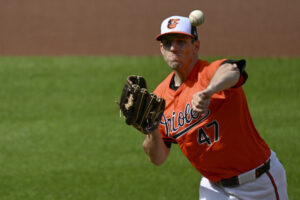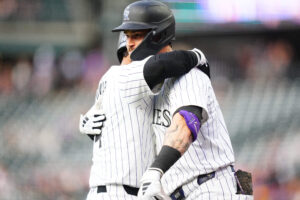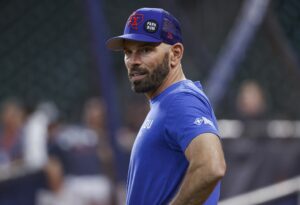Welcome to Week 12 of Ejection Inspection! The premise and ground rules are detailed here. The condensed version: each ejection from the previous week (Thursday through Wednesday) is listed in a table. The author – a former player/coach/umpire – analyzes each ejection and assigns it an entertainment rating of one to five Weavers in honor of late Baltimore Orioles manager Earl Weaver. (Side note: For the second time this year, current Orioles manager Brandon Hyde was ejected.)
(For a list of every article in this series, click here.)
There were 10 ejections in Week 12 – six managers and three players. Seven occurred on Saturday, June 15th. Those are detailed here. The rest can be found below.
| Date | Team | Opp | Inn. | Name | Pos | Umpire | Pos | Reason | ||
| 1 | Thu | 6/13 | ATL | PIT | 4/5 | Brian Snitker | Mgr | Tripp Gibson | HP | Arguing balls/strikes |
| 2 | Fri | 6/14 | KC | @MIN | T5 | Jorge Soler | RF | Hunter Wendelstedt | HP | Arguing balls/strikes |
| 3 | Sat | 6/15 | DET | CLE | T6 | Ron Gardenhire | Mgr | Manny Gonzalez | HP | Arguing balls/strikes |
| 4 | Sat | 6/15 | CWS | NYY | T8 | Welington Castillo | C | Phil Cuzzi | HP | Arguing balls/strikes |
| 5 | Sat | 6/15 | CWS | NYY | T8 | Rick Renteria | Mgr | Phil Cuzzi | HP | Protesting Castillo’s ejection |
| 6 | Sat | 6/15 | SEA | @OAK | T4 | Scott Servais | Mgr | Carlos Torres | HP | Arguing balls/strikes |
| 7 | Sat | 6/15 | SD | @COL | T5 | Manny Machado | SS | Bill Welke | HP | Arguing balls/strikes |
| 8 | Sat | 6/15 | SD | @COL | B6 | Andy Green | Mgr | Bill Welke | HP | Misunderstanding |
| 9 | Sat | 6/15 | SD | @COL | B6 | Matt Strahm | P | Mike Everitt | 3B | Bench jockeying |
| 10 | Sun | 6/16 | BAL | BOS | B4 | Brandon Hyde | Mgr | Tripp Gibson | HP | Arguing interference call at first |
Brian Snitker, Atlanta Braves Manager
When
Thursday, June 13th, vs. Pittsburgh Pirates, between the fourth and fifth
Umpire
Tripp Gibson (HP)
Description
Braves center fielder Ronald Acuña, Jr. was called out on strikes with runners on the corners to end the fourth inning. The pitch looked to be several inches above the zone. Snitker hollered from the dugout that the pitch was even with Acuña’s neck. He used his hands for a visual and added profane adjectives as he kept yelling. Gibson warned him to stop, but Snitker continued, so Gibson tossed him. Snitker then came out of the dugout to let off more steam before heading to the clubhouse.
Understand the frustration?
Yes. Not only did the pitch look high, but the Braves announcing team indicated that the strike zone was “a mystery,” in the words of Chip Caray. In fact, it’s safe to say that every manager in the league would have been thrown out over that pitch.
Was the ejection justified?
Yes, even though Snitker had a point. Balls and strikes are not to be argued. Furthermore, Gibson had warned him.
Entertainment Rating
One Weaver, although Snitker is fun to watch when he gets irritated. His arms become very active, and this was no exception.
Jorge Soler, Kansas City Royals right fielder
When
Friday, June 14, at Minnesota Twins, top of the fifth
Umpire
Hunter Wendelstedt (HP)
Description
Soler led off the top of the fifth in a scoreless game against Twins starter Kyle Gibson. The first pitch was about four to six inches below the knees, but Wendelstedt called it a strike. Soler threw his hands up, turned around, and walked up to Wendelstedt to complain. They talked back and forth briefly before Wendelstedt removed his mask and said, “Let me tell you something. You’d better shut your (expletive).” Soler started to argue some more, and Wendelstedt gave him the thumb. Wendelstedt then said some more, but the only thing that was clear from lip-reading was “not on strike one.”
Soler left the field as fired-up Royals manager Ned Yost charged up to Wendelstedt and angrily asked, “What is your problem? (Something unclear.) What did he say?” Wendelstedt’s response was not visible, since he had his back to the camera. Yost countered, “Don’t you tell ME to calm down when you threw his (expletive) out (snapping fingers) like that!” He asked two more times, “What did he say to you?” Wendelstedt gave a long, slow explanation. His mouth was mostly hidden other than “and he KNOWS not to do that.” After the explanation, Yost made a final expression of disapproval and then headed to the dugout.
Understand the frustration?
Yes. Not only was the pitch low, but the ejection was quick.
Was the ejection justified?
We don’t know what Soler said, so it’s hard to say for sure. However, even though Wendelstedt is known for having little patience with arguments from players, it probably was. If it wasn’t, Yost wouldn’t have been so accepting of the explanation.
Entertainment Rating
One Weaver for not being memorable.
Brandon Hyde, Baltimore Orioles manager
When
Sunday, June 16, vs. Boston Red Sox, bottom of the fourth
Umpire
Tripp Gibson (HP)
Description
With runners on the corners and one out, Orioles center fielder Keon Broxton laid down a bunt to the first base side of the mound. Anthony Santander – the runner on third – got a nice break home when the safety squeeze was put in play. Pitcher Colten Brewer fielded the ball, looked home and saw he had no play on Santander, and threw to first. Broxton was running WAY inside the foul line – several feet on the grass, in fact – and blocked the pitcher’s throwing lane to first. The throw nearly hit Broxton in the back of the head (it only missed because he ducked) and pulled the covering second baseman off the bag so he could catch the ball without hitting Broxton or being bowled over by him.
The Rule
It initially looked like Santander scored. However, Broxton by rule could not be safe at first. On the first base line, in the last half between home and first, there is a three-foot-wide box on the foul side of the base line. (One name for it is the 45-foot box; another is the three-foot box.) Batter-runners are required to run in that box. If the batter-runner is not in that box and a throw hits him or he otherwise interferes with a play, it is interference. The ball is dead, the batter-runner is out, and all runners must return to the bases they occupied at the time of the pitch. Since this happened, Santander had to return to third, so the score remained 2-1 in favor of the Red Sox.
Brandon Hyde Protests the Ruling
After a huddle from the umpires, Gibson called Hyde onto the field and explained the ruling. Hyde lost his mind. It was very hard to read his lips, other than to see that a lot of his words started with an F. Hyde was upset about two things – the interference call negated the advancement by the runners, turning it from a productive out to a wasted one. Furthermore, a run was taken off the board.
Understand the frustration?
Any time a run is taken off the board, a team is upset. Brandon Hyde knows the rule, so he most likely was upset with the result, not the action. The rule also seems to be misunderstood by a lot of the broadcasters. One example is Orioles color commentator Mike Bordick, who played in the majors for 14 years and should know better. He said there was “no call at first,” meaning that the runner couldn’t have interfered, since there was no play to interfere with. This is preposterous. The pitcher did not have a very wide window in which to throw. The first baseman was coming from the left of the bag at first, so the throw could only come from the inside of the foul line. That side of the bag was blocked by Broxton, who is 6’3”. Where else was Brewer supposed to throw? It would have been physically impossible to throw it to the outside, not only because of the severe angle of the throw, but because it still would have been blocked by Broxton.
The 45-foot box exists for plays exactly like this one. Calls for this rule to be eliminated show ignorance for both the rule and its purpose. (Author’s note: Earlier in the season, Chicago White Sox television play-by-play announcer Jason Benetti claimed that the box is unfair to the runner because he has to leave that box to touch first. Wrong. I’ve done it many times. Stay close to the foul line and tap first with your left foot as you run by. It’s easy. If I can do it, major leaguers certainly can.)
Was the ejection justified?
Brandon Hyde yelled profanity in the umpire’s face. It absolutely was justified.
Entertainment Rating
Three Weavers. Hyde went nuts.
Leaderboard
After 11 weeks, here are the leaders. Fight-related ejections are not counted toward the leaderboard.
Individual: Detroit Tigers manager Ron Gardenhire (five)
Team (excluding fights): Cincinnati Reds (seven)
Umpire (excluding fights): Mike Estabrook (six)
Look for Week 13 on Thursday, June 20th.
Evan Thompson played baseball as a youth and teenager. He also umpired between 1995 and 2004 and has coached at the high school level.
Main Photo
Embed from Getty Images






